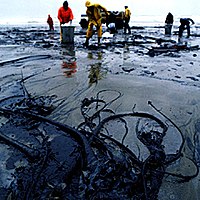
Photo from wikipedia
The Shoreline Response Program (SRP) is an adjustment within an Incident Management System (IMS) intended to improve current practices during planning and preparedness for and from the initial response to… Click to show full abstract
The Shoreline Response Program (SRP) is an adjustment within an Incident Management System (IMS) intended to improve current practices during planning and preparedness for and from the initial response to an oil spill. An SRP builds on the recognized strengths of an IMS-based organization and of a Shoreline Cleanup Assessment Technique (SCAT) program that utilizes an integrated and focused approach to streamline and better coordinate the decision and planning processes and the operational implementation activities. An SRP is an extension of the traditional SCAT program but with a broader focus on strategic and tactical planning to minimize the short- and long-term impacts of oil on shorelines, the efforts and costs involved in a shoreline response, and the volumes of waste that would be generated. The objective of this discussion is to identify and address five specific areas for improvement in the shoreline component of an IMS that are associated with the separation of responsibility, streamlining the Environmental Unit (EU), internal communications, Operations support and training. These improvements essentially constitute a paradigm shift and are described in the context of the integration of an SRP into the IMS, the relationship between an SRP and the Environmental Unit, and the enabling of a more formal support approach to the Operations Section by an SRP SCAT-OPS Liaison program. The inclusion of an SRP concept in drills, exercises and preparedness training can directly change the management culture and improve the ability to respond quickly and effectively during the initial response phase. Not implementing an SRP at the very outset of a spill response, when typically the best opportunities exist for the removal of bulk oil, can have significant long-term consequences. Shifting an emphasis of management and physical resources from, often only partially successful, on-water activities to onshore shoreline activities when oil can be picked up more rapidly and effectively can significantly reduce i) the footprint of the response, ii) the duration and scale of the shoreline operation, iii) the exposure of shore zone resources to the oil, and so accelerates ecological and socio-economic recovery. The concept of an SRP as an integrated "single point of contact" for all shoreline-related issues and activities is likely to become more significant as IMS models evolve with potentially fewer people in a more decentralized Command Post and with a greater number of IMS planners, managers, and decision-makers participating from remote locations and/or in a virtual environment.
Journal Title: Journal of environmental management
Year Published: 2020
Link to full text (if available)
Share on Social Media: Sign Up to like & get
recommendations!